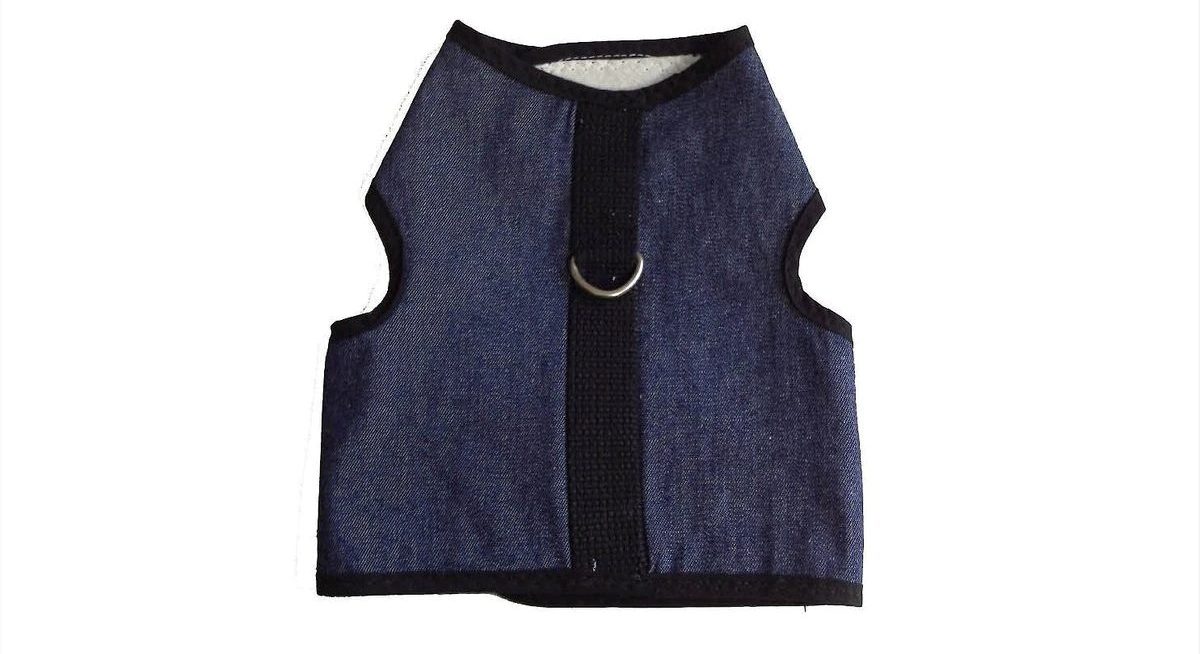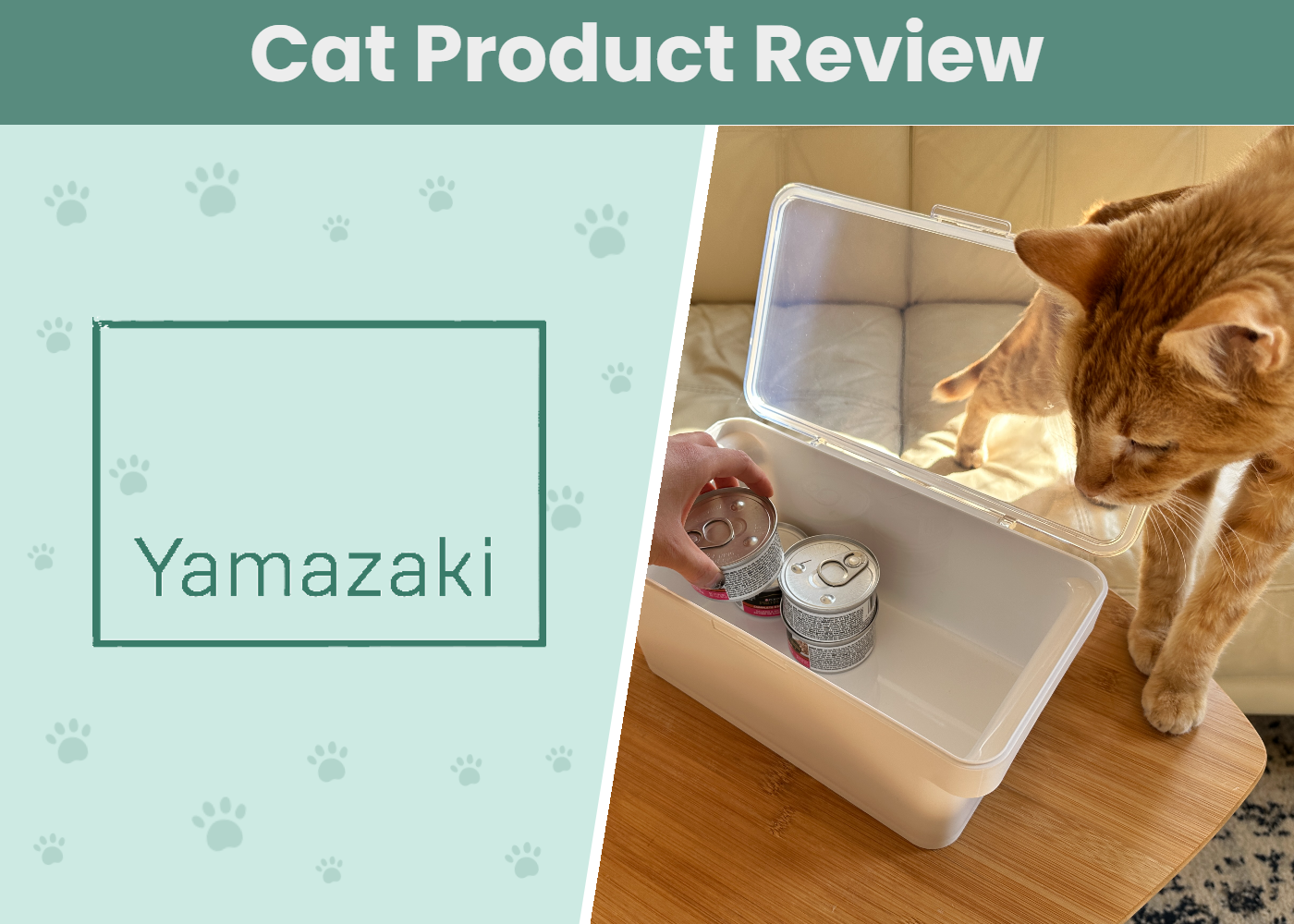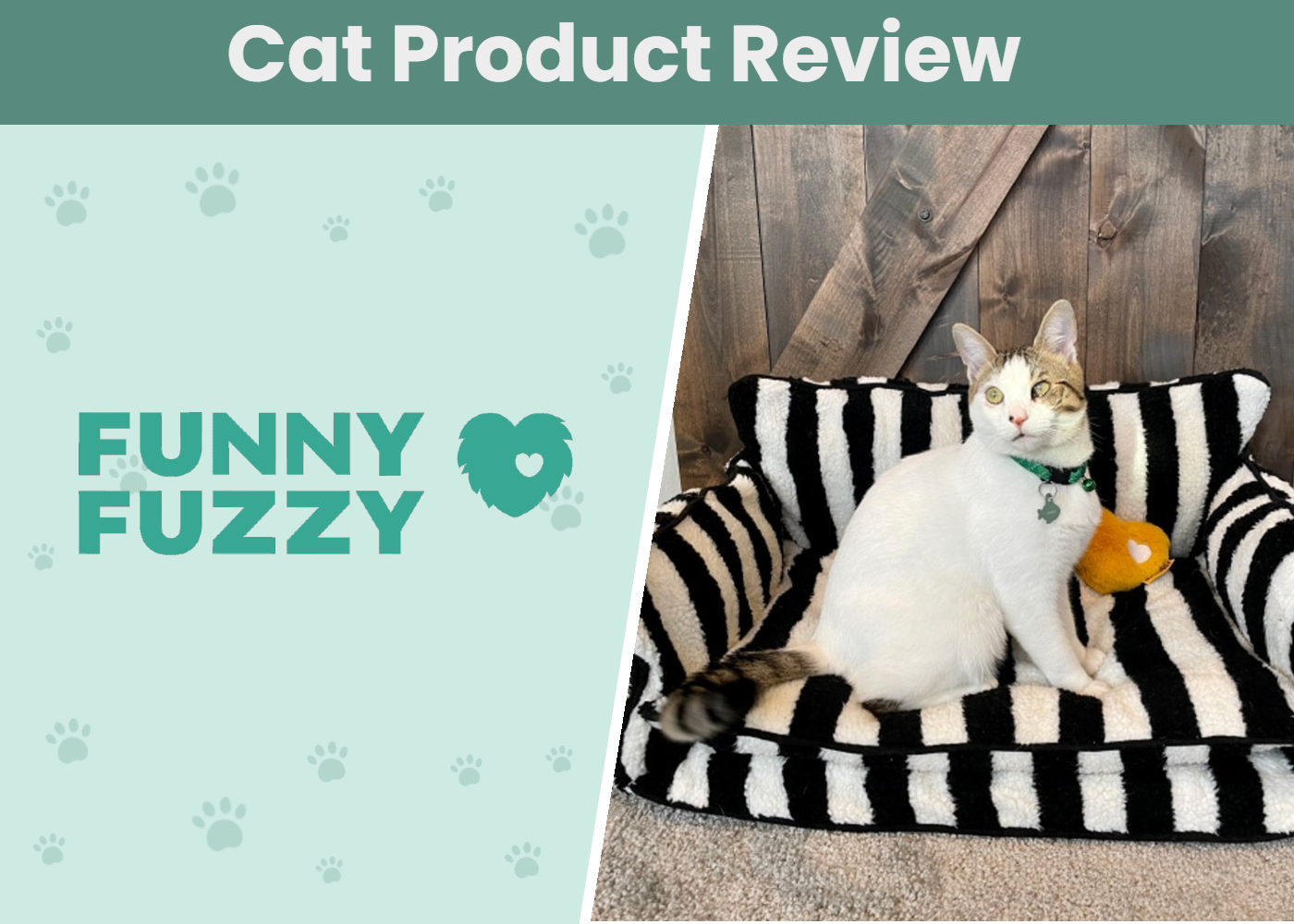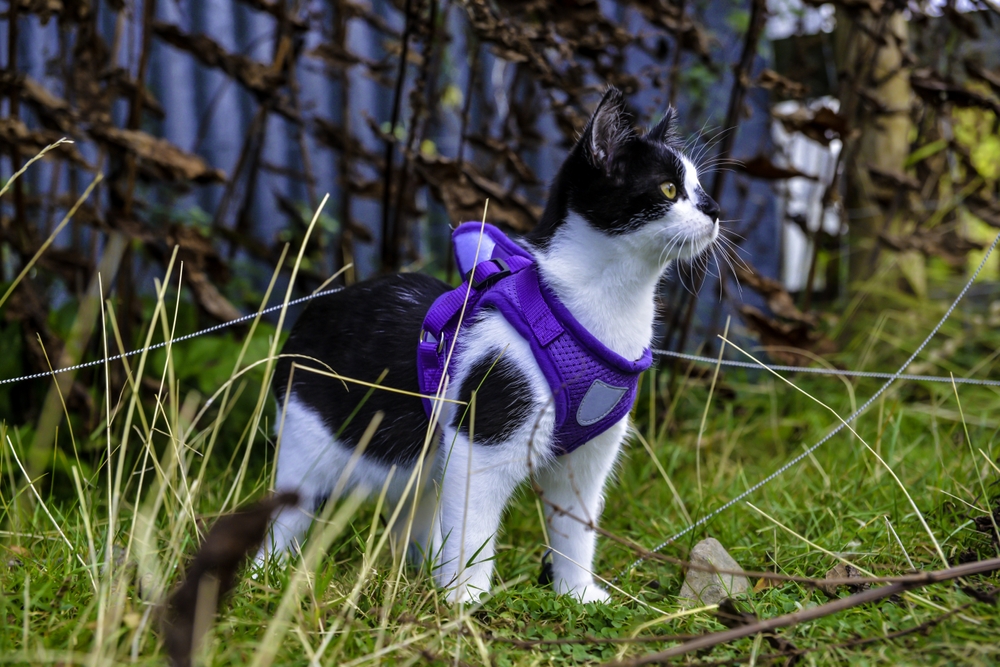
To help you decide on a kitten harness, we’ve gathered the top 10 kitten harnesses. We’ve included quick reviews, pros and cons, and a buyer’s guide so you know exactly what you’re looking for when shopping for this item. Keep reading to find the best (and safest) harness for your kitten!
A Quick Comparison of Our Favorites in 2024
| Image | Product | Details | ||
|---|---|---|---|---|
| Best Overall |

|
Hepper Harness and Leash Set |
|
CHECK PRICE |
| Budget Buy |

|
Size Right Snag-Proof Adjustable Cat Harness |
|
CHECK PRICE |

|
Travel Cat & Stray Cat Harness and Leash Set |
|
CHECK PRICE | |
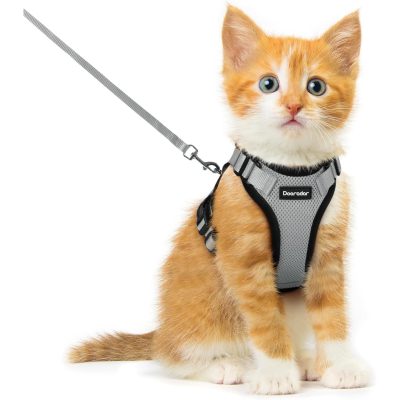
|
Dooradar Cat Harness and Leash Set |
|
CHECK PRICE | |
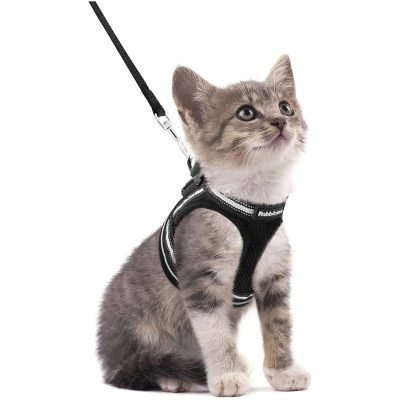
|
rabbitgoo Cat Harness and Leash Set |
|
CHECK PRICE |
The 10 Best Kitten Harnesses
1. Hepper Harness and Leash Set – Best Overall

| Sizes: | XXS, XS, S, M, L, XL |
| Colors: | Black |
| Closure Type: | Buckle |
The best overall kitten harness this year is the Hepper Harness and Leash Set. With multiple adjustable points, you can adjust this harness to fit any kitten’s frame, so you’re getting the best fit possible. This harness also has added Velcro straps that help get a snugger, more comfortable fit for your kitten. Between the adjustability and the soft material used to make this harness, your kitty should be more than comfy. Plus, if you’re planning on being outside at night with your kitten, you’ll be glad to know this harness by Hepper has reflective stripes so your pet can be better seen when there’s less light.
The only complaint we found about this harness was that some cat parents felt it was too bulky, so a few cats didn’t like wearing it. Other than that, you can only get this harness in a single color at the moment, so if you’re looking for more design options, you may want to look elsewhere.
At Catster, we’ve admired Hepper for many years and decided to take a controlling ownership interest so that we could benefit from the outstanding designs of this cool cat company!
- Multiple points to adjust for the best fit
- Made from extra soft material
- Reflective stripes for safety
- Very secure for optimum safety
- Can only get in a single color
2. Size Right Snag-Proof Adjustable Cat Harness – Budget Buy

| Sizes: | One size |
| Colors: | Blue, black |
| Closure Type: | Buckle |
When looking for the best kitten harness for the money, consider the Size Right Snag-Proof harness! This harness goes over the head and is designed to be escape-proof so sneaky kitties can’t get out. The O-ring swivels, so it helps prevent your cat from getting tangled up in their leash, and the durable nylon used in this harness is built to last. Most cat parents loved that this harness was extremely lightweight, so it was almost like their cats weren’t wearing it at all (and cats seemed to like that, too).
The size of this harness seems to be a little iffy, though. Some cat parents said this harness didn’t fit large cats, while a couple of others stated this harness didn’t fit itty bitty kittens. So, this may be a harness that’s best for an older kitten.
- Best value
- Helps prevent escape
- Extremely lightweight
- Sizing may be iffy
3. Travel Cat & Stray Cat Harness and Leash Set

| Sizes: | XS, S, M, L |
| Colors: | Black, gray, orange, red, money, 90s, groovy |
| Closure Type: | Velcro, buckle |
Are you looking for a premium option for your kitten? Then this 2-in-1 harness and leash by Travel Cat might be just the thing! Supposedly inspired by a cat from a video game, this harness is created from super soft and breathable material to ensure your kitten’s comfort. Extra strong Velcro allows for adjustability and safety, while the snap clip is designed to keep your pet from getting tangled in the leash. This harness also has a reflective stripe so the kitty can be seen in low light and a fun decorative pocket. Cat parents loved how well-built this harness was.
However, a few people said this harness was not escape-proof, which was a significant negative; in particular, they felt the neck was too wide. Some also said the sizing chart seemed to be off, so if you’re getting this for a kitten, we suggest going with the smallest size, even if you might think the kitten will fit into a larger one.
- Stylish
- Well-built
- Comfortable
- Not escape-proof for all cats
- Neck may be too wide
- Sizing chart seems off
4. Dooradar Cat Harness and Leash Set
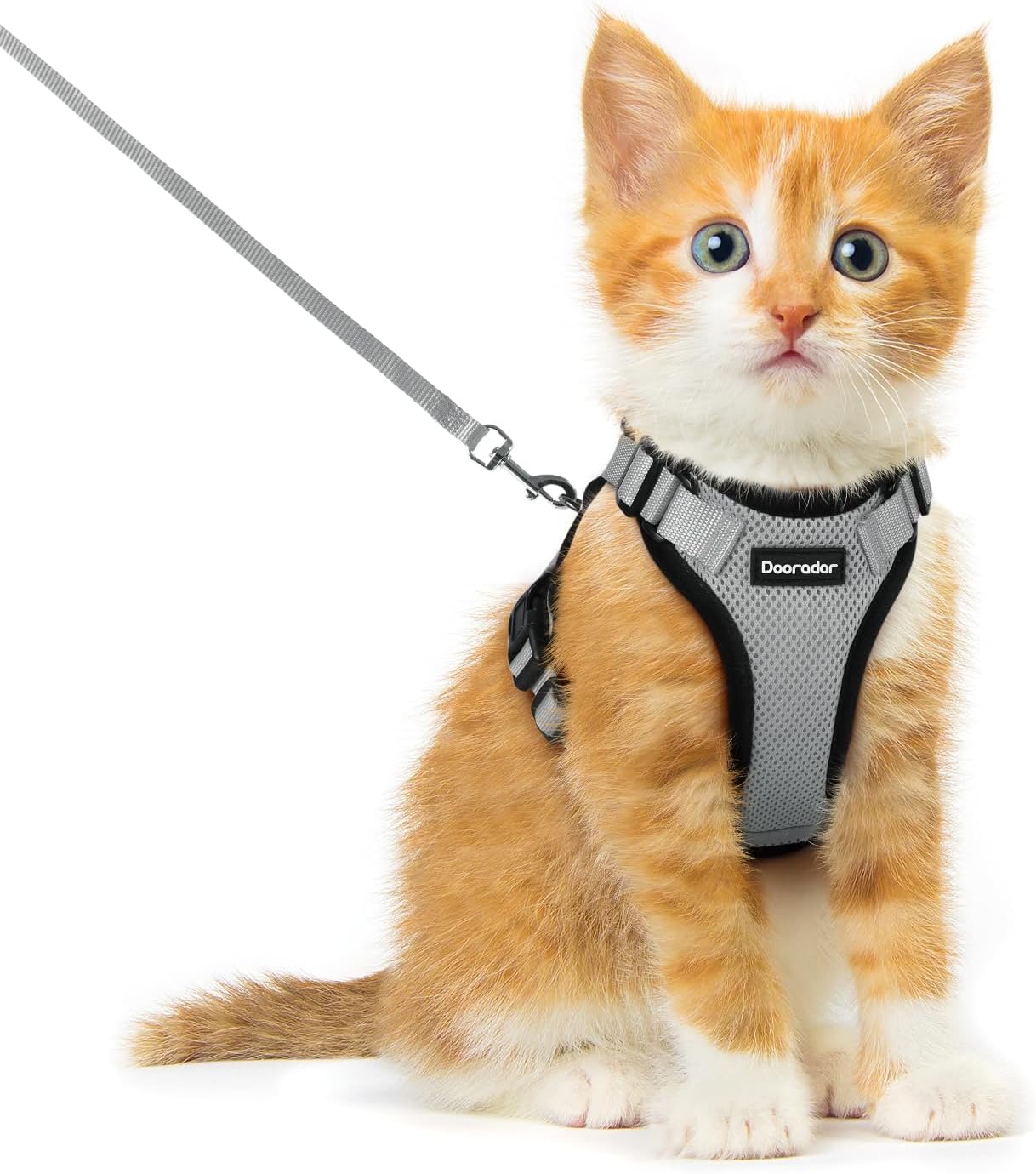
| Sizes: | XXS, XS, S, M |
| Colors: | Black, blue, gray, green, light blue, orange, pink, purple, red, yellow |
| Closure Type: | Buckle |
This simple harness is exceptionally lightweight to keep your kitten comfortable while wearing it and has cushioning in the front that can help protect your kitty from injuries. The lining won’t catch on your kitten’s hair, so you don’t need to worry about skin irritation, which is always a plus. This harness offers four buckles for adjustability, so you can get the best fit for your kitty, and it has two quick-release buckles in case of emergency. It’s also designed so kittens can’t wiggle out of it, keeping them safer on walks. Most felines seemed quite comfy in this one!
This Dooradar harness wasn’t without issues, though. The sizing chart for this harness seemed to be off, as several people claimed their harnesses were either too big or too small despite them measuring their cats. We recommend getting the smallest size for your kitten. Some extremely smart kitties were able to escape despite this being billed as escape-proof, too.
- Cushioning in front to prevent injury
- Won’t catch on cat fur
- Cats seemed comfortable wearing
- Sizing chart was off
- A few smart kitties escaped
5. rabbitgoo Cat Harness and Leash Set
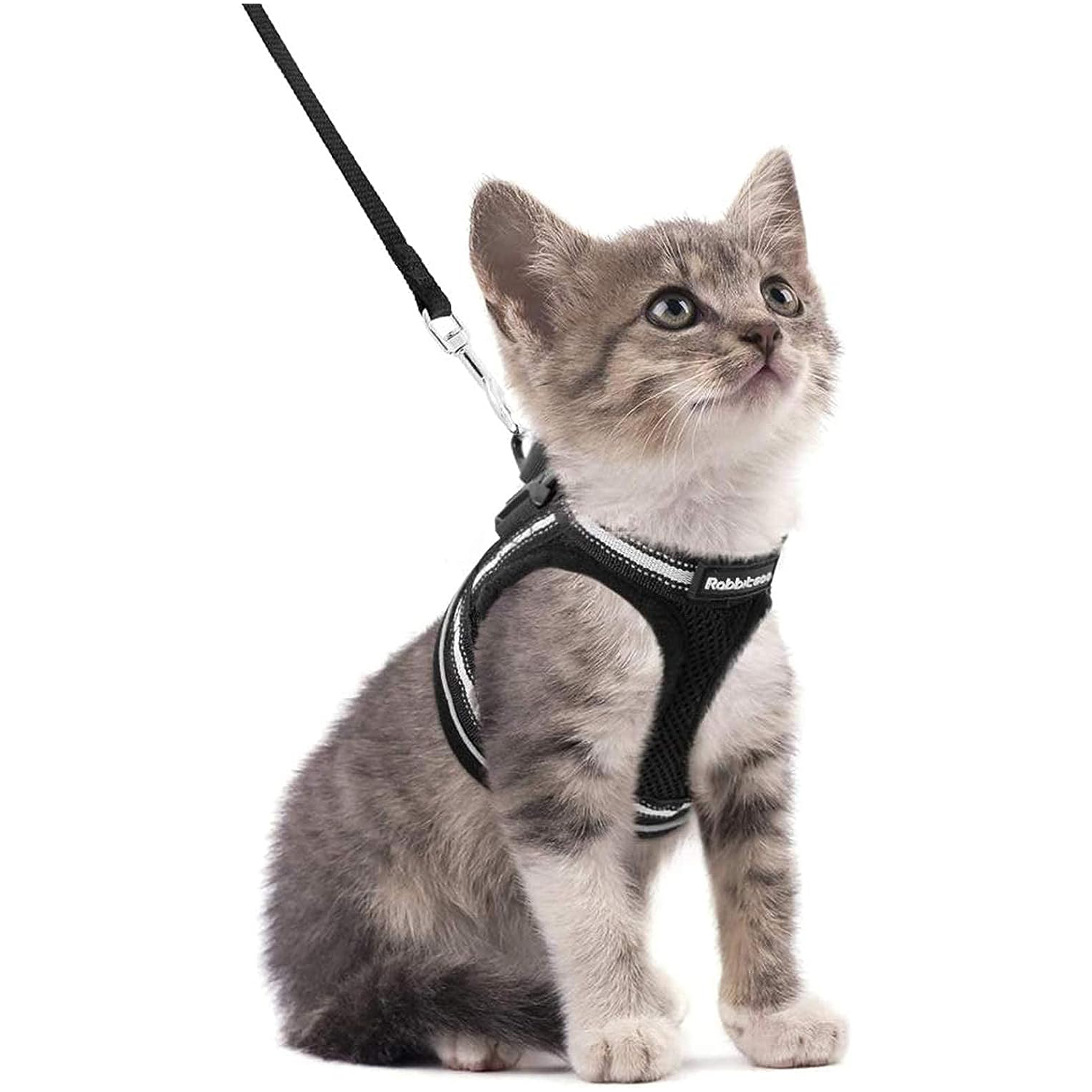
| Sizes: | S, M, L, XL |
| Colors: | Grey, black, blue, yellow, green, orange, purple, pink, red |
| Closure Type: | Buckle |
This harness by rabbitgoo was extremely popular with cat parents. Featuring a back buckle and magic tape, this harness is supposed to be more difficult for cats to get out of, which keeps kitty safer while on walks. Since the rabbitgoo harness is designed as a vest, it also won’t pull against your kitten’s neck, so you don’t have to worry about them choking themselves. Air mesh padding helps prevent injury while keeping your cat comfy in the harness, and the fast-release buckle means you can get your kitty out quickly if you need to. People found this harness to be sturdy, as well as easy to take on and off.
A couple of cat parents said this ended up being too small for their cats, though, despite them taking proper measurements. Since you want to use this on your kitten, the smallest size is the A handful of people had the leash loop snap off in the first few months, too.
- Sturdy
- Easy to put on and remove
- Fast-release buckle for emergencies
- May be too small
- Leash loop snapped off on some harnesses
6. Kitty Holster Cat Harness
| Sizes: | XS, S/M, M/L, XL |
| Colors: | Denim blue, black, gray, hunter green, purple, blazin’ red bandana, tiger stripe |
| Closure Type: | Back clip |
If your kitty suffers from skin allergies, this might be the harness for them, as the lining on this harness is undyed cotton, which makes it better for those with sensitive skin. Though the Kitty Holster is a breeze to put on, it’s difficult for cats to get out of, so it should help keep your pet safe. And this harness is supposed to be less stressful to put on your kitty due to the fuzzy fasteners it has. Cat parents raved about how strong the Velcro on this harness is, and several commented that their cats seemed to feel safer with it on.
The flip side of the strong Velcro is that some cat parents had difficulty pulling it apart so they could put it on their kitty in the first place. Some felines were also scared of the sound of the Velcro ripping apart and wouldn’t wear the harness. A few people felt as if this harness was too bulky for their kitties, as well.
- Might be good for kitties with skin allergies
- Super strong Velcro
- Some cats seemed to feel safer with it on
- Velcro is so strong it can be hard to pull apart
- Sound of Velcro scared some cats
- May be too bulky for some cats
7. Barkbay Harness and Leash Set
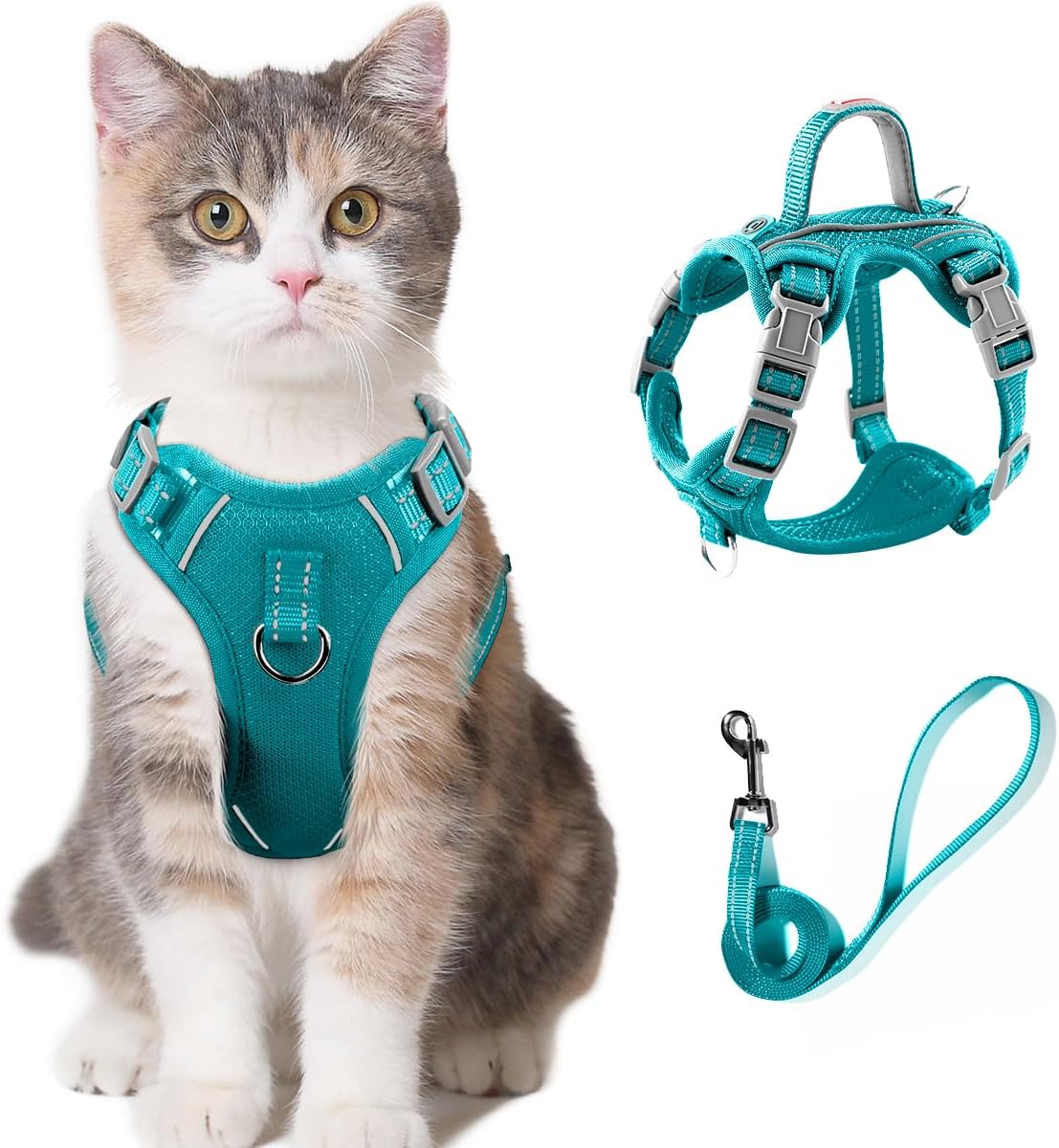
| Sizes: | XXS, XS, S |
| Colors: | Black, blue, orange, pink, purple, red |
| Closure Type: | Buckle |
This 360° surround vest design allows this harness to be evenly distributed on your kitten, so there’s no pulling or choking when your cat is on a leash. This same design also makes it more challenging for your kitty to escape from, which improves safety while you and your cat are on walks. As this harness is made with reflective materials, it provides your cat with higher visibility when there is low light, also improving safety. A tag pocket for your kitty’s ID is available, and the harness has two D rings so you can retain better control over your pet.
While people liked the sturdiness of this harness, they found the buckles a bit too unforgiving; many reported difficulty opening them. There were also complaints of the material being too stiff and the overall harness being overly bulky.
- Evenly distributed to avoid pulling or choking
- Claims to be hard to escape from
- Two D rings for better control of cat
- Buckles were difficult for some
- Material may be too stiff
- A few people found the harness overly bulky
8. Red Dingo Classic Nylon Cat Harness & Leash
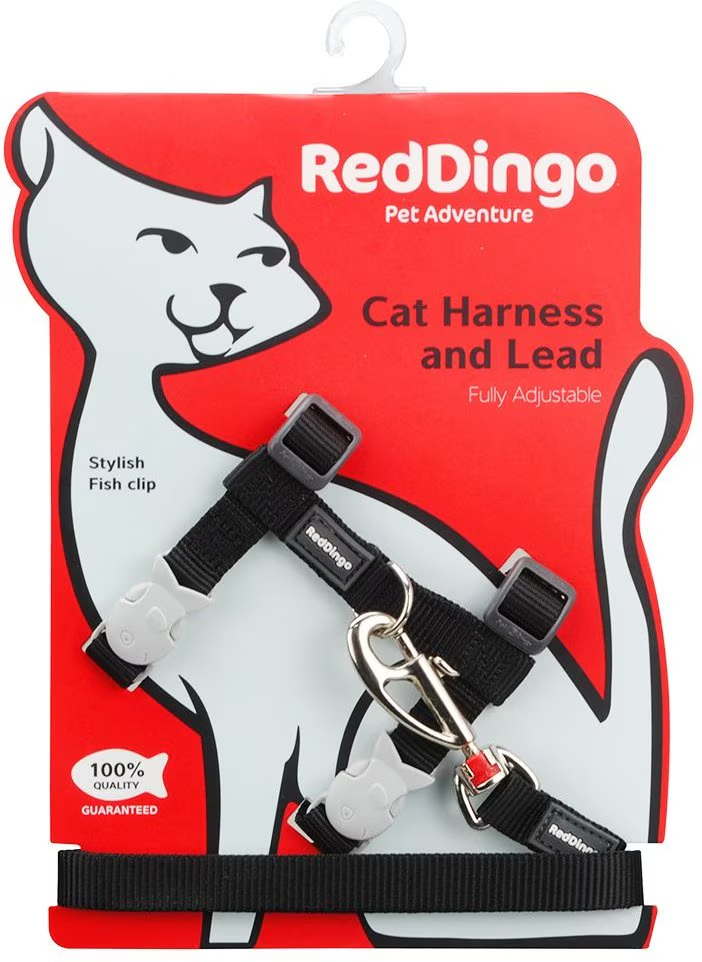
| Sizes: | One size |
| Colors: | Black, green, pink, red |
| Closure Type: | Buckle |
If you’re looking for an extremely simple harness for your kitten, this one by Red Dingo may be the one for you. Made with durable nylon, this harness merely consists of two loops. The material used is abrasion-resistant, so you don’t need to worry about it rubbing against your kitten and harming them. It also features adorable fish clips on the buckles, which are secure and strong. Plus, the recommended weight for this harness goes from 3 pounds to 25 pounds, so it should be able to fit your cat for their entire life!
A few cat parents found the strap between the chest and neck loop too short, which resulted in choking and discomfort when cats lowered their heads. Some people said they had fastener clasps break on them quite quickly, and one person mentioned that this harness got tangled up with a tree branch and didn’t release their cat, so that could be a concern.
- Simple for those not looking for bells and whistles
- Material is abrasion-resistant
- Should fit kitty for their whole life
- May cause choking and discomfort for some cats
- A few people had fastener clasps break
- Could get tangled up in something
9. Heywean Cat Harness and Leash
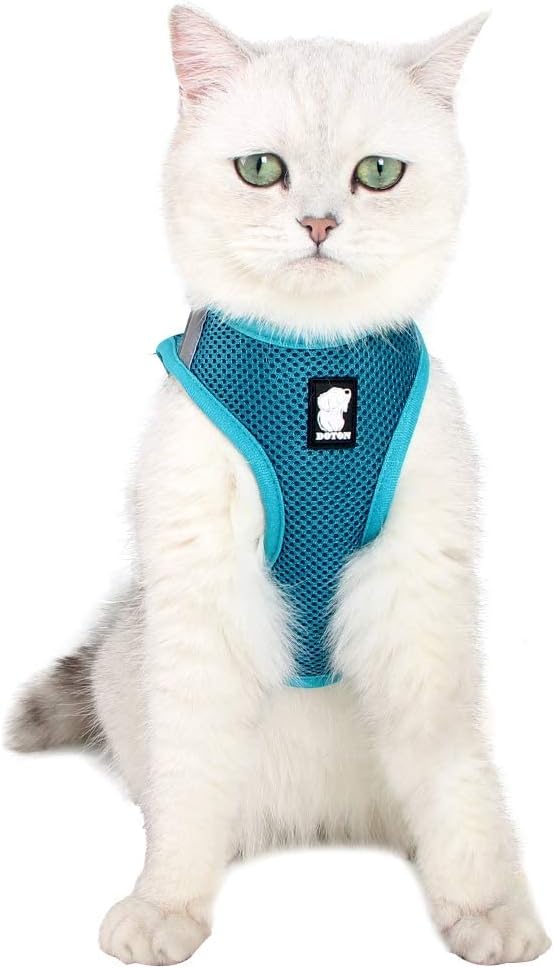
| Sizes: | XS, X, M, L |
| Colors: | Blue, gray, yellow, green, pink, silver, turquoise |
| Closure Type: | Buckle |
Are you trying to find a stylish harness for your kitten? This harness by Heywean might be right for you, then! It comes in several fun and bright colors, so your cat will really stand out. That brightly colored material does more than attract attention, though, as it’s also durable, moisture-absorbing, and odor-reducing. It’s also lightweight and soft enough to make your cat feel cozy in their harness. Because this harness is styled like a vest, it offers your cat an equal distribution of pressure, so no one area is choking or causing discomfort. And with the strong buckle and Velcro fasteners, your cat should stay in the harness rather than get out.
Many people enjoyed how much stretch there was to this harness and the padding on it, but they didn’t like the fact the buckle wasn’t adjustable. There were also quite a few people who said their kitties were able to get out of this harness. A couple of cat parents also had the plastic on the buckles break within a month or so.
- Stylish with fun colors
- Absorbs moisture and odors
- Cat parents enjoyed the stretch and padding of this harness
- Buckle isn’t adjustable
- Many cats managed to get out of this harness
- Some had the buckles break quickly
10. PetSafe Come with Me Kitty Nylon Cat Harness & Bungee Leash

| Sizes: | S, M, L |
| Colors: | Black/silver, red/black, royal blue/navy, dusty rose/burgundy, lilac/deep purple |
| Closure Type: | Buckle |
Here’s another relatively simple harness with two points to adjust to fit your kitten. Best of all, this harness comes with a detailed guide on how to adjust it properly so your pet gets the best fit possible. Besides the adjustability, this harness is made from a stretchy material that prevents tugging and has a stopper to prevent escape. There are also quick-release buckles that make it easy to take this off your kitty in a pinch.
Many cat parents felt this harness was pretty solid, but there were a few issues. Some found minor details that were wonky, like clips sewn upside down, while others had trouble putting the harness on in the first place. There were also a couple of complaints about the neck loop choking kitties, which is a concern.
- Two adjustable points
- Comes with a detailed guide on sizing
- Quick-release buckles
- Not enough attention paid to minor details of harness
- Some had trouble putting the harness on their cat
- Neck loop may choke some kitties
Buyer’s Guide: Selecting the Best Kitten Harness
So, what should you look for when purchasing a harness for your kitten? There are a few main factors that should be considered when making a decision.
Durability of Materials
Kitten harnesses come in a variety of materials, including nylon, mesh, polyester blends, and cotton. When choosing one for your kitten, you want to get the most durable material you can find. Depending on how often you take your cat out, your kitty could be wearing this often, so wear and tear will occur. You want a material that is durable enough to not break down, rip, or tear quickly or easily.
Nylon is one of the top picks for durability, as it is long-lasting and strong. Cotton is fairly durable, too, while also being comfortable and easy to wear for long amounts of time. Polyester blends and mesh may be less resistant to rips and tears, though they do have upsides like being lightweight or offering breathability.
Safety
Safety is key when it comes to kitten harnesses. The whole point of having your little one wear a harness is to keep them safe when out and about, so you want to be sure any harness you consider will get the job done. This means you want a harness that isn’t easy for the kitten to slip out of once it is on and closures that are sturdy. Some harnesses come with extras like reflective stripes to help keep your cat safe while in low light, as well.
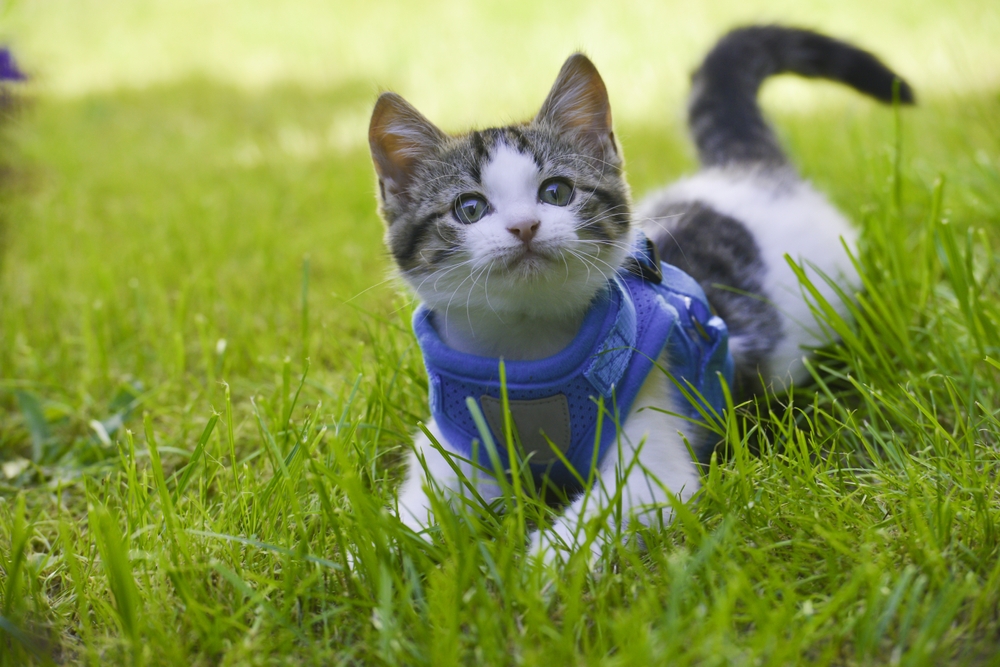
Closure Style
How a harness is kept closed is important, too. Most harnesses will be closed with buckles or Velcro (or both!). Buckles are simple to use and often can be fast-release, which is helpful if you ever need to release your cat from their harness quickly. Velcro straps can help you get the harness more precisely fitted to your kitten, but Velcro may not always be the strongest. It can also pick up dirt easily when you’re outdoors.
Comfort
If your kitten isn’t comfortable wearing a harness, then they’re going to refuse to wear it, which defeats the whole purpose of getting one. You want to find a harness that isn’t too bulky or heavy and one that provides breathability so they don’t get overheated. You also don’t want a harness that will rub against and irritate skin, and you need a harness that lets your kitten be mobile. It may take a few tries to figure out what your cat is most comfortable with, but there should be something they don’t hate out there!
Style
You probably noticed that many harnesses on this list look similar. That’s because there are two main styles when it comes to kitten harnesses—vest style and “H” style. Vest harnesses cover more of your kitten’s body so that pressure is equally divided, which can help prevent choking if a cat pulls too hard. This style is also more difficult for kittens to escape from and can often be more comfortable. “H” style is the style of harness that has a neck loop and a chest loop. They’re much simpler than vest harnesses and quite easy to put on, but they can also be simpler for a cat to escape.
Reviews
The best way to make a better-informed decision on which harness is best for your kitten is to check out what other people are saying. Reading reviews like the ones here can give you a quick rundown of what’s good and bad about a harness, and checking reviews from other cat parents let you know how well a harness works in the real world.
Conclusion
And now for a quick rundown of our top three reviews!
For the best overall kitten harness, we recommend the Hepper Harness and Leash Set, as it’s extra soft and offers multiple points of adjustment, so you get the best fit for the kitten. If you’re looking for the best kitten harness for the money, take a look at the Size Right Snag-Proof Adjustable Cat Harness; this harness is lightweight and designed to prevent escape. Finally, our choice for a premium option is the Travel Cat & Stray Cat Harness and Leash Set, since it’s stylish and well-built.
Featured Image Credit: Abi’s Photos, Shutterstock
Contents
- A Quick Comparison of Our Favorites in 2024
- The 10 Best Kitten Harnesses
- 1. Hepper Harness and Leash Set – Best Overall
- 2. Size Right Snag-Proof Adjustable Cat Harness – Budget Buy
- 3. Travel Cat & Stray Cat Harness and Leash Set
- 4. Dooradar Cat Harness and Leash Set
- 5. rabbitgoo Cat Harness and Leash Set
- 6. Kitty Holster Cat Harness
- 7. Barkbay Harness and Leash Set
- 8. Red Dingo Classic Nylon Cat Harness & Leash
- 9. Heywean Cat Harness and Leash
- 10. PetSafe Come with Me Kitty Nylon Cat Harness & Bungee Leash
- Buyer’s Guide: Selecting the Best Kitten Harness
- Conclusion





